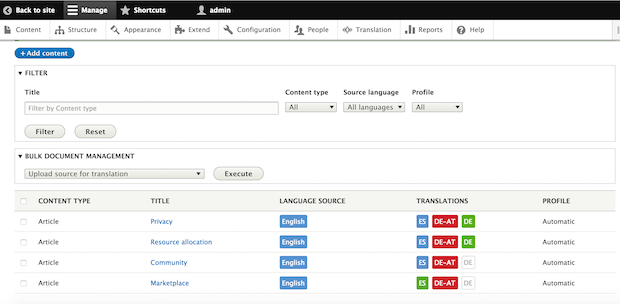Lingotek’s Translation Network is a cloud-based solution that connects all your global content in one place, giving you the power to manage your brand worldwide. Our technology pairs with the best-in-class applications, such as Drupal, to continuously push dynamic multilingual content to all of your global markets.
Lingotek’s collaboration with - and development work for - the Drupal community began over four years ago with Drupal 6. Our first Drupal module was released in fall of 2011 for Drupal 6. We now have contributed modules available for both Drupal 7 and Drupal 8.
These modules empower Drupal site owners to target different markets by providing them with various options for translation (machine, community, and professional) as well as connecting their Drupal site to our cloud-based Translation Network.
Our Drupal 7 module enhanced the functionality of Drupal 7 core and also integrated with popular contributed modules such as Field Collections, Panels, and more. The ability to integrate with these modules was crucial because complex sites built for easier digital experiences often require different data modelling options. But providing high quality support for such different possibilities and potential information architectures is not always easy.
So why are we so proud of the Drupal 8 multilingual experience?
The massive improvements of Drupal 8 for multilingual features and APIs allowed us to provide better support than with previous releases of Drupal or any other CMS on the market. For example, Lingotek supports the translation of several different content data structures for Drupal 7. However, with Drupal 8, if you follow the best practices on the creation of your content structures we will fully support them out-of-the-box.
At this point, you may be wondering, how Lingotek can help you? If you are a site owner, you will be able to easily translate your content or configuration. Our bulk management forms allow you to upload and request multiple translations of your content in all your locales with a single submit. And if you choose to, the translations will be automatically downloaded and published as soon as they are available.

If you are a front-end developer, you may have worked on multilingual projects where translations were handed in late in your project cycle. Sometimes, since the text labels can be so different between different languages, your new translations can break your layouts. With Lingotek you can use automatic translations, which may not be good enough for your end users, but can help demonstrate how the site will look like in a language you don’t speak.
If you are a back-end developer, you may need to develop custom modules. These custom modules could include custom entities and/or field types or result in your own configurations. Then you’d be tasked with making them translatable, which may seem like a daunting task. In fact, with Drupal 8 it’s easier than with Drupal 7 or any other CMS by far! If you integrate with Lingotek, the good news is that you don’t need extra work as soon as your data structures are translatable with Drupal 8 core. For more information about how to make your data structures translatable, check out this helpful example module git history.
Drupal 8 is a great platform to work with not only because it is so multilingual capable out-of-the box, but also because you can easily expand while maintaining the translatability of your data. Drupal 8’s multilingual core offers a robust multilingual foundation, making the integration process much more seamless.
That’s why we’re excited to announce that Drupal 8 users can now benefit from Lingotek’s Translation Network.
For more information about Lingotek’s Translation Network please visit www.lingotek.com. For additional information about Lingotek’s Drupal contributed modules, visit either www.lingotek.com/drupal or www.drupal.org/project/lingotek.





